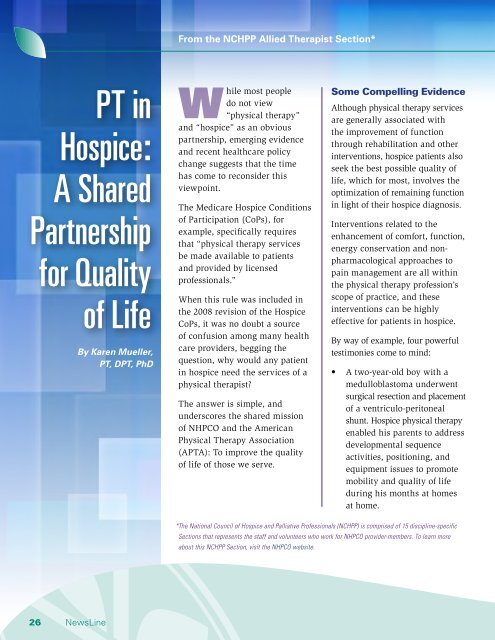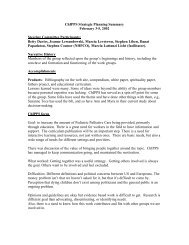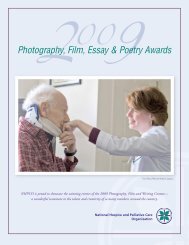PDF version - National Hospice and Palliative Care Organization
PDF version - National Hospice and Palliative Care Organization
PDF version - National Hospice and Palliative Care Organization
Create successful ePaper yourself
Turn your PDF publications into a flip-book with our unique Google optimized e-Paper software.
From the NCHPP Allied Therapist Section*<br />
PT in<br />
<strong>Hospice</strong>:<br />
A Shared<br />
Partnership<br />
for Quality<br />
of Life<br />
By Karen Mueller,<br />
PT, DPT, PhD<br />
While most people<br />
do not view<br />
“physical therapy”<br />
<strong>and</strong> “hospice” as an obvious<br />
partnership, emerging evidence<br />
<strong>and</strong> recent healthcare policy<br />
change suggests that the time<br />
has come to reconsider this<br />
viewpoint.<br />
The Medicare <strong>Hospice</strong> Conditions<br />
of Participation (CoPs), for<br />
example, specifically requires<br />
that “physical therapy services<br />
be made available to patients<br />
<strong>and</strong> provided by licensed<br />
professionals.”<br />
When this rule was included in<br />
the 2008 revision of the <strong>Hospice</strong><br />
CoPs, it was no doubt a source<br />
of confusion among many health<br />
care providers, begging the<br />
question, why would any patient<br />
in hospice need the services of a<br />
physical therapist?<br />
The answer is simple, <strong>and</strong><br />
underscores the shared mission<br />
of NHPCO <strong>and</strong> the American<br />
Physical Therapy Association<br />
(APTA): To improve the quality<br />
of life of those we serve.<br />
Some Compelling Evidence<br />
Although physical therapy services<br />
are generally associated with<br />
the improvement of function<br />
through rehabilitation <strong>and</strong> other<br />
interventions, hospice patients also<br />
seek the best possible quality of<br />
life, which for most, involves the<br />
optimization of remaining function<br />
in light of their hospice diagnosis.<br />
Interventions related to the<br />
enhancement of comfort, function,<br />
energy conservation <strong>and</strong> nonpharmacological<br />
approaches to<br />
pain management are all within<br />
the physical therapy profession’s<br />
scope of practice, <strong>and</strong> these<br />
interventions can be highly<br />
effective for patients in hospice.<br />
By way of example, four powerful<br />
testimonies come to mind:<br />
• A two-year-old boy with a<br />
medulloblastoma underwent<br />
surgical resection <strong>and</strong> placement<br />
of a ventriculo-peritoneal<br />
shunt. <strong>Hospice</strong> physical therapy<br />
enabled his parents to address<br />
developmental sequence<br />
activities, positioning, <strong>and</strong><br />
equipment issues to promote<br />
mobility <strong>and</strong> quality of life<br />
during his months at homes<br />
at home.<br />
*The <strong>National</strong> Council of <strong>Hospice</strong> <strong>and</strong> <strong>Palliative</strong> Professionals (NCHPP) is comprised of 15 discipline-specific<br />
Sections that represents the staff <strong>and</strong> volunteers who work for NHPCO provider-members. To learn more<br />
about this NCHPP Section, visit the NHPCO website.<br />
26 NewsLine









